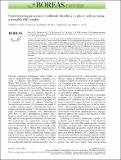Files in this item
Understanding processes of sediment bleaching in glacial settings using a portable OSL reader
Item metadata
| dc.contributor.author | King, Georgina | |
| dc.contributor.author | Sanderson, David C. W. | |
| dc.contributor.author | Robinson, Ruth Alison Joyce | |
| dc.contributor.author | Finch, Adrian Anthony | |
| dc.date.accessioned | 2014-05-09T09:31:03Z | |
| dc.date.available | 2014-05-09T09:31:03Z | |
| dc.date.issued | 2014 | |
| dc.identifier | 99136988 | |
| dc.identifier | 11e1c4bc-af08-4797-b7f5-051a1f4316ff | |
| dc.identifier | 84907815423 | |
| dc.identifier | 000342220000014 | |
| dc.identifier.citation | King , G , Sanderson , D C W , Robinson , R A J & Finch , A A 2014 , ' Understanding processes of sediment bleaching in glacial settings using a portable OSL reader ' , Boreas , vol. 43 , no. 4 , pp. 955-972 . https://doi.org/10.1111/bor.12078 | en |
| dc.identifier.issn | 0300-9483 | |
| dc.identifier.other | ORCID: /0000-0002-3689-1517/work/38002291 | |
| dc.identifier.uri | https://hdl.handle.net/10023/4744 | |
| dc.description | This research was part funded by NERC studentship, Grant Number: F008589/1. The APC was paid through RCUK Open Access block grant funds. | en |
| dc.description.abstract | Analysis of a high-resolution suite of modern glacial sediments from Jostedalen, southern Norway, using a portable optically stimulated luminescence (OSL) reader, provides insights into the processes of sediment bleaching in glacial environments at the catchment scale. High-magnitude, low-frequency processes result in the least effective sediment bleaching, whereas low-magnitude, high-frequency events provide greater bleaching opportunities. Changes in sediment bleaching can also be identified at the scale of individual bar features: tails of braid-bars and side-attached bar deposits have the lowest portable reader signal intensities, as well as the smallest conventional OSL residual doses. In addition to improving our understanding of the processes of sediment bleaching, portable reader investigations can also facilitate more rapid and comprehensive modern analogue investigations, which are commonly used to confirm that the OSL signals of modern glacial sediments are well bleached. | |
| dc.format.extent | 18 | |
| dc.format.extent | 1385455 | |
| dc.language.iso | eng | |
| dc.relation.ispartof | Boreas | en |
| dc.subject | Glacial sediments | en |
| dc.subject | Optically stimulated luminescence (OSL) reader | en |
| dc.subject | Sediment bleaching | en |
| dc.title | Understanding processes of sediment bleaching in glacial settings using a portable OSL reader | en |
| dc.type | Journal article | en |
| dc.contributor.institution | University of St Andrews. Earth and Environmental Sciences | en |
| dc.contributor.institution | University of St Andrews. Scottish Oceans Institute | en |
| dc.contributor.institution | University of St Andrews. St Andrews Sustainability Institute | en |
| dc.contributor.institution | University of St Andrews. School of Geography and Geosciences | en |
| dc.contributor.institution | University of St Andrews. Marine Alliance for Science & Technology Scotland | en |
| dc.contributor.institution | University of St Andrews. St Andrews Isotope Geochemistry | en |
| dc.identifier.doi | https://doi.org/10.1111/bor.12078 | |
| dc.description.status | Peer reviewed | en |
This item appears in the following Collection(s)
Items in the St Andrews Research Repository are protected by copyright, with all rights reserved, unless otherwise indicated.

